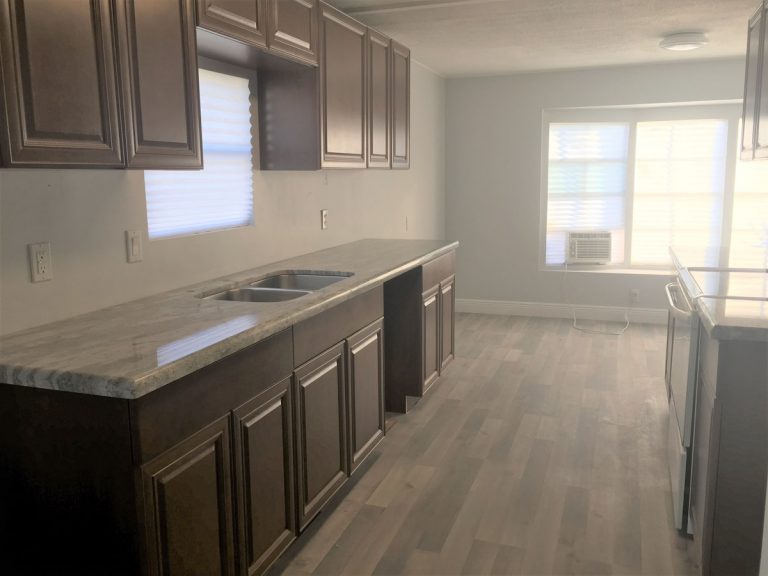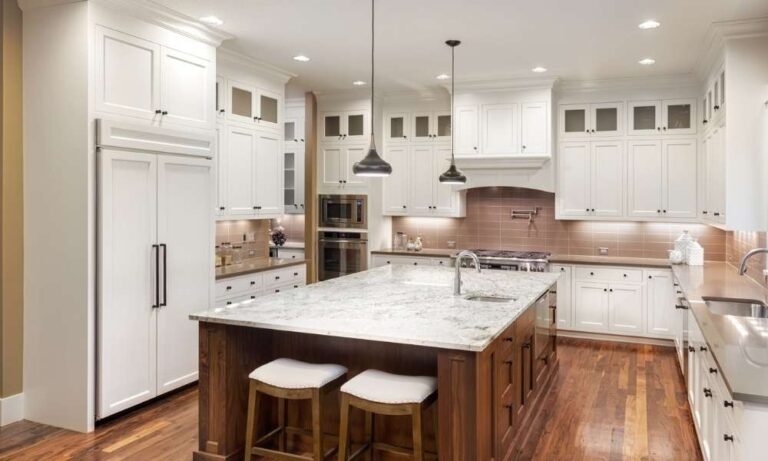Understanding the Need for Mobile Home Cabinet Replacement

Mobile home cabinets, like any other part of your home, are subject to wear and tear over time. While they may have served you well for years, there comes a point when they need to be replaced. This can be due to a variety of factors, including age, damage, or simply a desire for a fresh look.
Signs That a Cabinet Needs Replacement
It’s important to know when your cabinets have reached the end of their lifespan. Here are some telltale signs that indicate it’s time for a replacement:
- Doors and drawers are sagging or sticking: This is a common sign of wear and tear, especially if the cabinets are made of particleboard or MDF. The weight of the contents can cause the doors and drawers to sag over time, making them difficult to open and close.
- Damaged or warped surfaces: Water damage, scratches, or dents can affect the appearance and functionality of your cabinets. If the damage is significant, it may be more cost-effective to replace the cabinets than to try to repair them.
- Outdated design: Mobile homes often come with standard cabinets that may not be to your liking. If you’re looking to update your home’s style, replacing the cabinets can make a big difference.
- Insufficient storage space: If your cabinets are too small or lack adequate organization, you may need to replace them with larger or more functional options.
Benefits of Replacing Old Cabinets
Replacing old cabinets offers several advantages:
- Improved functionality: New cabinets can provide more storage space, better organization, and easier access to your belongings.
- Enhanced aesthetics: Replacing outdated cabinets can give your mobile home a fresh and modern look. You can choose from a wide variety of styles, colors, and materials to match your personal taste.
- Increased value: Updated cabinets can enhance the overall value of your mobile home, making it more appealing to potential buyers if you decide to sell in the future.
Choosing the Right Replacement Cabinets

Replacing your mobile home cabinets is a great way to upgrade your living space and enhance its functionality. With a wide range of options available, selecting the right cabinets can be overwhelming. This guide will help you navigate the process and make informed decisions.
Cabinet Materials, Mobile home cabinet replacement
Choosing the right cabinet material is crucial for durability, aesthetics, and budget. Consider these popular options:
- Laminate: Laminate cabinets are a budget-friendly option, offering durability and resistance to scratches and moisture. They come in various colors and patterns, allowing for customization. However, laminate can be susceptible to chipping and may not be as visually appealing as other materials.
- Wood: Wood cabinets provide a classic and elegant look, offering natural beauty and warmth. They are durable and can be refinished or repainted over time. However, wood is more expensive than laminate and requires regular maintenance to prevent warping and damage.
- Melamine: Melamine cabinets are a cost-effective alternative to wood, offering a similar appearance with greater durability. They are resistant to scratches, moisture, and heat, making them suitable for high-traffic areas. However, melamine is not as customizable as wood and may not have the same level of natural beauty.
Cabinet Styles
Mobile home cabinet styles vary widely, ranging from traditional to contemporary. Consider your home’s overall design and your personal preferences when choosing a style.
- Traditional: Traditional cabinets feature ornate details, such as raised panels, crown molding, and decorative hardware. They create a timeless and elegant look that complements classic home styles.
- Contemporary: Contemporary cabinets emphasize clean lines, simple designs, and minimalist hardware. They create a modern and sleek look that complements modern and minimalist home styles.
- Transitional: Transitional cabinets blend traditional and contemporary elements, offering a balanced and versatile look that suits various home styles. They feature subtle details and sleek designs, creating a harmonious blend of classic and modern aesthetics.
Cabinet Finishes and Hardware
Cabinet finishes and hardware play a significant role in creating the overall look and feel of your mobile home.
- Finishes: Cabinet finishes range from glossy to matte, offering various colors and textures. Consider the existing color scheme of your mobile home and your desired ambiance when choosing a finish.
- Hardware: Cabinet hardware includes knobs, pulls, and hinges. Choose hardware that complements the cabinet style and your home’s overall design. Consider materials like brushed nickel, chrome, or brass, and select designs that align with your personal taste.
Cabinet Sizes
Choosing the right cabinet sizes is crucial for maximizing storage space and functionality. Consider the available space in your mobile home and the intended use of each cabinet.
- Standard Sizes: Most mobile home cabinets come in standard sizes, ensuring compatibility and ease of installation. However, custom sizes may be available for specific needs.
- Upper and Lower Cabinets: Upper cabinets are typically smaller and used for storing less frequently used items, while lower cabinets are larger and used for storing heavier items.
- Drawer Configurations: Cabinets can have different drawer configurations, such as single drawers, double drawers, or multiple drawers of varying sizes. Choose a configuration that meets your storage needs and preferences.
The Cabinet Replacement Process: Mobile Home Cabinet Replacement

Replacing mobile home cabinets can be a rewarding DIY project that transforms your living space. It allows you to customize your kitchen or bathroom with new styles and functionalities. This step-by-step guide provides detailed instructions, tips, and essential tools to help you successfully replace your cabinets.
Preparing the Area for Replacement
Before starting the replacement process, it is crucial to prepare the area thoroughly. This involves clearing out belongings, removing old cabinets, and ensuring a clean and safe workspace.
- Clear Out Belongings: Empty all drawers and shelves in the cabinets you intend to replace. Remove any items that could hinder your work or get damaged during the process.
- Remove Old Cabinets: Carefully dismantle the existing cabinets. Start by removing doors and drawers, then detach the cabinet boxes from the walls. Take note of the placement of screws and any other attachments for reference during the installation of new cabinets.
- Clean the Area: Wipe down the walls and floor where the cabinets were located to remove dust, debris, and any adhesive residue from the old cabinets. This ensures a clean and smooth surface for installing the new cabinets.
Installing New Cabinets
Installing new cabinets requires careful measurements, leveling, and secure attachment. This section Artikels the key steps involved in installing new cabinets in your mobile home.
- Measure and Plan: Before purchasing new cabinets, accurately measure the available space for the cabinets. Consider the height, width, and depth of the cabinets and ensure they fit within the designated area. Also, plan the placement of cabinets, including any corner cabinets or upper cabinets.
- Level and Mark: Use a level to ensure the walls are plumb and mark the locations for the new cabinets. This ensures that the cabinets are installed straight and securely. You can use a pencil or marker to mark the wall for placement.
- Attach Cabinets: Depending on the type of cabinets, they may be attached to the walls using screws, brackets, or other fastening methods. Follow the manufacturer’s instructions for attaching the cabinets to the wall. Use a drill and appropriate screws to secure the cabinets firmly. For added stability, you can use cabinet shims to level and adjust the cabinets before attaching them permanently.
Finishing Touches
After installing the new cabinets, it’s time to add the finishing touches to complete the project. This involves installing hardware, cleaning up, and making sure everything is in its place.
- Install Hardware: Attach cabinet doors, drawers, knobs, pulls, and other hardware. Ensure that the hardware is securely installed and aligns properly with the cabinet openings. This step can be time-consuming, so take your time and ensure everything is installed correctly.
- Clean Up: Remove any debris or leftover materials from the area. Vacuum or sweep the floor to ensure a clean and tidy workspace. It’s important to clean up after each step of the project to maintain a safe and organized work environment.
- Organize and Enjoy: Once the new cabinets are installed, organize your belongings and enjoy your newly renovated space. Place your items in the drawers and shelves, and admire the transformation of your kitchen or bathroom. This step is rewarding and allows you to appreciate your hard work.
Tips for Handling Challenges
Replacing cabinets in a mobile home can present unique challenges, such as working with limited space and dealing with uneven walls. This section provides tips to help you overcome these challenges.
- Working with Limited Space: Mobile homes often have limited space, making it challenging to maneuver large cabinets. Consider using smaller cabinets or pre-assembling them outside the mobile home before bringing them inside. This helps minimize the risk of damage and allows for easier installation.
- Dealing with Uneven Walls: Mobile home walls can sometimes be uneven, which can make it difficult to install cabinets straight. Use cabinet shims to level and adjust the cabinets before attaching them permanently. This ensures that the cabinets are level and secure, even on uneven walls.
Essential Tools and Materials
Having the right tools and materials is crucial for a successful cabinet replacement project. This section lists the essential tools and materials you will need.
- Measuring Tape: Accurate measurements are essential for purchasing the right cabinets and ensuring a proper fit.
- Level: A level ensures that the cabinets are installed straight and securely.
- Drill: A drill is necessary for attaching cabinets to the walls using screws.
- Screwdrivers: You will need various screwdrivers for attaching cabinet doors, drawers, knobs, and other hardware.
- Saw: A saw may be needed to trim cabinets to fit the space precisely.
- Cabinet Shims: Shims are used to level and adjust cabinets before attaching them permanently, especially on uneven walls.
- Safety Glasses: Always wear safety glasses to protect your eyes from flying debris.
- Work Gloves: Work gloves provide protection for your hands and improve your grip.
- New Cabinets: Choose cabinets that match your style and needs, and ensure they are compatible with your mobile home’s layout.
- Cabinet Hardware: This includes doors, drawers, knobs, pulls, and other hardware that you will need to complete the installation.
Mobile home cabinet replacement can be a significant undertaking, requiring careful consideration of both functionality and aesthetics. When seeking replacements, particularly for bathroom cabinets, exploring options like overstock bathroom wall cabinets can be advantageous. These cabinets often offer a blend of affordability and style, providing a practical and visually appealing solution for mobile home bathroom renovations.
Mobile home cabinet replacement can be a significant undertaking, but it’s a great way to refresh the look and functionality of your space. If you’re considering a bathroom remodel, you might want to explore cream colored bathroom wall cabinets , which can offer a classic and timeless aesthetic.
Regardless of the style you choose, remember to carefully measure your space and consider the materials and functionality that best suit your needs when replacing mobile home cabinets.
